
¤ Andean Region
- Ecuador, Peru, Bolivia,
Chile.
¤ The North
- Colombia, Venezuela
¤ Caribbean
Coast - Guyana, Suriname, French Guiana
¤ Central / Southeast
- Argentina, Uruguay, Paraguay.
More on Chili Peppers.
"Aji" (pronounced Ah-hee) is the word for Chili Peppers in Spanish Speaking South America and the Caribbean. It is from the Taino word "axí". The Taino were the original inhabitants of much of the Caribbean, but were driven almost extinct by the Spanish and diseases they brought. The Spanish took the word "Aji" to much of South America.
The Spanish took Mexican Chilis back to Spain, and there specialized in breeding sweet and semi-hot chilis, unlike the Portuguese, who spread stinging hot chilis throughout the world.
The Andes mountains extend from the central spine of Colombia all the way down to the tip of Chile. Colombia cuisine is generally pretty mild, so we place it in the North, with this section covering Peru, Ecuador, Bolivia and Chile.
While the rest of the world concentrates on C. annuum, C. frutescens, and C. chinense, the Andes region along the west coast of South America has stuck with its own native species: C. pubescens and C. baccatum with almost no involvement with those other species.
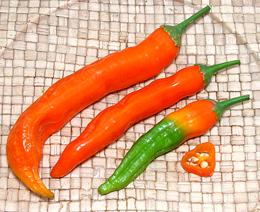 [C. baccatum var. pendulum]
[C. baccatum var. pendulum]
This chili is most commonly associated with Peru but is also used
in Bolivia. The baccatum species originated in Peru and/or
Bolivia and still dominates the Andes region today. The name means
"Chili Yellow", but it ripens to a bright orange. Some sources say
they turn yellow ("amarillo") when cooked, but they actually stay
pretty orange. This is a fairly hot variety
(H7) but variable, and grows
to 3 to 6 inches long. In Peru they are used mostly fresh, but in
Bolivia they are dried and ground. A number of products are made from
this chili, see Details and Cooking.
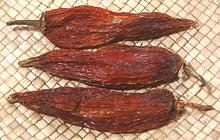 [C. baccatum var. pendulum]
[C. baccatum var. pendulum]
These are dried Aji Amarillo. The photo specimens, purchased from
Catalina's Market in Los Angeles, were typically 4.3 inches long by 1.15
inches across. Seeds from one of these were planted to produce the photo
specimens above.
 [Wild Chilean Chili Pepper; Cumari (Brazil); C. chinense]
[Wild Chilean Chili Pepper; Cumari (Brazil); C. chinense]
This tiny chili, is very popular in Peru, and is also well known in Brazil. It is a fairly hot chili (H8) with a fruity flavor, and is a popular houseplant in Peru, so it is instantly available when fruiting. The usual way of eating it is to crush a fresh ripe chili with your fork to get some juice on it, then use the fork to flavor the food.
The plant is bushy and can produce hundreds of chilis, but has just
recently been put into cultivation. My two plants did almost nothing
the first year, but grew rapidly the second year and produced around 80
chilis per plant. In their third year they look to be producing about
140 per plant. The chilis were 0.280 inches diameter or less, but some
varieties are said to produce fruit approaching 1/2 inch. Don't leave
ripe chilis on the bush. One year some bird came and ate nearly 200
chilis in one day - birds can't detect chili heat and aren't bothered
by it.
 [C. baccatum var. pendulum]
[C. baccatum var. pendulum]
This chili is most commonly associated with the north coast of Peru,
where it is essential to the proper flavor of the Ceviches made there.
It is also used in other dishes, particularly rice dishes, and described
as having a "citrus spice" taste when cooked.
It is smaller and a bit hotter than the Aji Amarillo, around
H8, and can be green, yellow or
red, and white and purple varieties are known. The name comes
from a common lemon yellow variety, also called "Lemon Drop". The photo
specimens were from my own plants.
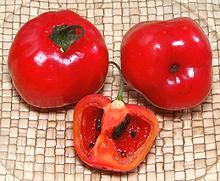 [Rocoto, Locoto (Peru, Bolivia); Manzano, Chile de Caballo, Qsacyol
(Guatemala); C. pubescens]
[Rocoto, Locoto (Peru, Bolivia); Manzano, Chile de Caballo, Qsacyol
(Guatemala); C. pubescens]
Native to northwestern South America, these chilis have been cultivated for about 8000 years. They are the same species as the orange Manzano chilis of Mexico, but red ones predominate in South America. They are popular in mountainous regions because they can stand colder weather than most chilis. A major chili in Peru, they are also used in the far North of Chile, but are too hot for the rest of the country. The bush can live 15 years and grow as tall as 10 feet.
They Range from green to yellow, orange and bright red, round to bell
shape and 1 to 3 inches diameter, they are fairly hot
(H8), and have dark brown or black
seeds. They have fairly thick walls so they do not dry well. Rocoto is
the only widely cultivated species of C. pubescens. The photo
specimens were purchased from a large market in Los Angeles (Burbank)
that specializes in Mexican, Central and South American foods, mixed
in with orange Manzanos.
Details and Cooking
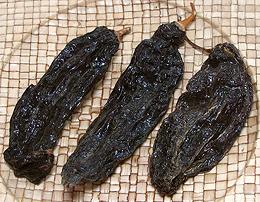 [C. baccatum]
[C. baccatum]
This is the second most common chili in Peru, after the Aji Amarillo.
It is similar in size, a bit larger, but deep red and very mild
(H1), with a sweet, berry like,
slightly smoky flavor. Usually dried by the growers before taking to
market, they are popular for use in stews and with fish and chicken.
In North America, they are uncommon dried, but more available as a
paste.
Details and Cooking
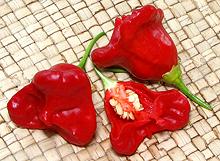 [C. baccatum]
[C. baccatum]
This oddly shaped chili is probably native to the region around Bolivia,
but is now grown, mainly as a curiosity, in North America, the Caribbean
and Europe. The flesh is thin but crisp and it has rather little
heat (H2), all of which is
concentrated up near the stem. While its characteristics do not strongly
encourage culinary usage, as a decorative the plant puts out a lot of
bright red chilis that hang like little bells, about 1-5/8 inches
across the widest part. It yields well only in the first year.
 [Peppadew® Pepper, Malawi Piquanté, Sweet Piquanté Pepper;
C. baccatum]
[Peppadew® Pepper, Malawi Piquanté, Sweet Piquanté Pepper;
C. baccatum]
These chilis are best known from South Africa, where they are cored and
pickled with plenty of sugar. They clearly originated from South America,
and may still be found there. They are of moderate heat
(H3) with a taste similar
to red bell peppers.
Details and Cooking.
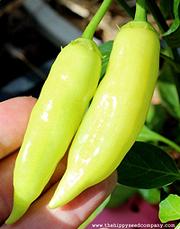 [Aji Verde; C. baccatum]
[Aji Verde; C. baccatum]
This is the dominant chili in Chile, where really hot chilis are avoided.
This one is moderately hot (
H5) similar to a Jalapeño. They are usually eaten when
light green or yellow-green, but will eventually mature to red. They can be
up to almost 4 inches long.
Photo borrowed from The
Hippy Seed Company until the seeds they sold me bear fruit.
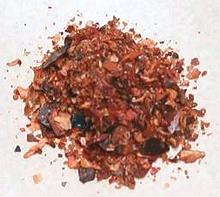 [Merkén]
[Merkén]
This is a smoked chili flake made from Aji Cacho de Cabra (Goat Horn Chili),
and is a specialty of the Mapuche people of southern Chile. The chilis are
dried, smoked then ground to flake and mixed with salt (merkén natural),
or about 70% chili, 20% salt, and 10% coriander seed (or 7% coriander seed
and 3% cumin seed) (merkén especial). The photo specimen, imported from
Chile, was fairly hot, distinctly smokey, and did include cumin. Subst: I have ground up Guatemalan Chili Cobanero, which
worked well. Others suggest a mix of Smoked Paprika and a little Hot Chili
Powder. Ground Chipotle are considered much too hot.
 These four chili pastes are much used in Peru and Ecuador, and to a
lesser extent in Bolivia and southwest Colombia. Because the only
significant ingredients are Chilis, Salt and Citric Acid, they can be
used in many recipes where fresh chilis are called for but are not
available. All these pastes were made in Peru and purchased from a
large Los Angeles Hispanic market, or on-line.
These four chili pastes are much used in Peru and Ecuador, and to a
lesser extent in Bolivia and southwest Colombia. Because the only
significant ingredients are Chilis, Salt and Citric Acid, they can be
used in many recipes where fresh chilis are called for but are not
available. All these pastes were made in Peru and purchased from a
large Los Angeles Hispanic market, or on-line.
¤ Aji Amarillo: (upper left) This is
the most important paste, made from fresh Aji
Amarillo chilis. Like them, it is quite hot, but not excessively so.
¤ Aji Mirasol: (upper right) This
paste is made from dried Aji Amarillos,
called Aji Mirasol. Like the Amarillo paste, it is fairly hot but not
excessively so.
¤ Aji Rocoto: (lower left) This is
the second most important paste, made from fresh
Aji Rocoto chilis. It is quite a bit
hotter than the Aji Amarillo pastes.
¤ Aji Panca This paste, made from dried
Panca chilis, is far milder than any of the other Peruvian chili pastes
and has a slightly smoky flavor.
Here we consider only Colombia and Venezuela as Guyana, Suriname and French Guiana are inseparable from the Caribbean. For those chilis we refer you to our page Chilis of the Caribbean.
Northern South America is noted for relatively mild cuisine. Chili sauces are made as condiments, and a few dishes adopted from outside the region feature chilis. Colombia actually grows a huge amount of Tabasco and Cayenne chilis, but for export to North America and Europe, not for local consumption.
In the mountains of Central Colombia and along the Pacific coast, what few Chilis are used are the same varieties used in Peru. On the Caribbean coast, the Aji Dulce predominates, and other Caribbean chilis are used very cautiously.
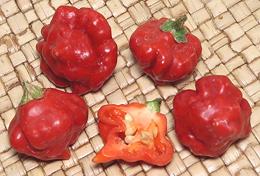 [Aji Cachucha, Ajicito; C. chinense]
[Aji Cachucha, Ajicito; C. chinense]
This chili is a variety of the fiercely hot Scotch Bonnet, and is very
popular in Venezuela, and on the Caribbean coast of Colombia. My new plant
was vigorous and produced some samples. I cut one open and was instantly
assailed by the unmistakable aroma of a super-hot chili. I bit into a slice.
The taste was sharp and stinging, an apt introduction to the terrible flames
to come. The flames never came, just the tropical fruity taste of the Scotch
Bonnet without the heat. In some recipes of the Caribbean coast, a number of
Aji Dulce will be combined with a single hot Scotch Bonnet or Habanero.
These chilis are about 1.12 inches diameter by 1.10 inches high, including
the pointy tail.
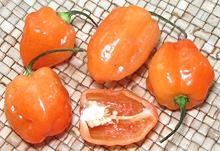 [C. chinense]
[C. chinense]
These hot chilis are not so much used in Colombian and Venezuela, but
are essential to a few dishes, particularly Columbian Aji Picante dip
and/or condiment. Those shown in the photo are the Orange Habanero
which dominates in California, but these chilis come in red and yellow
also. They feature very high heat (
H10) and a fruity flavor.
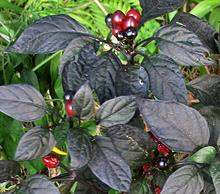 [C. annum]
[C. annum]
This chili was developed in Colombia, and is now fairly well known. With
its small round fruits, deep black maturing to bright red, and it's
black-purple leaves, it is quite striking. It is a decorative rather
than culinary chili. The photo is from a plant I had, and I was quite
disappointed with both hotness and flavor, but it did look good.
This Region, consisting of Argentina, Uruguay and Paraguay, is almost a "chili free zone". It is extremely beef, pasta, and baked goods oriented, and under very heavy European influence (particularly Spanish and Italian), essentially no native population at all. Moderately hot Chili Flake (Aji Molido / Aji Triturado) is used very cautiously, as in most of Europe, but mild Spanish Paprika is quite common. Bell Peppers are used a fair amount.
 I can include this fresh chili only because I've found in an Argentine
cookbook (written in Spanish) a single recipe for "Sopa Norteña"
which calls for one aji picante, defined specifically as "Locoto".
Norteña probably refers to Bolivia, where the
Locoto chili is widely used. OK, it's
not specifically an Argentine recipe, but it is in an Argentine cookbook
written in Argentina, and it implies Locoto chilis might be somewhat
available in Argentina. I've been told many Argentine verdularias (green
grocers) are from Bolivia, so that would be where to look. For details
see Manzana / Aji Rocoto
I can include this fresh chili only because I've found in an Argentine
cookbook (written in Spanish) a single recipe for "Sopa Norteña"
which calls for one aji picante, defined specifically as "Locoto".
Norteña probably refers to Bolivia, where the
Locoto chili is widely used. OK, it's
not specifically an Argentine recipe, but it is in an Argentine cookbook
written in Argentina, and it implies Locoto chilis might be somewhat
available in Argentina. I've been told many Argentine verdularias (green
grocers) are from Bolivia, so that would be where to look. For details
see Manzana / Aji Rocoto
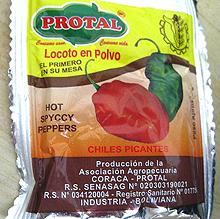 [Locoto en Polvo, Chiles Picantes (Spanish); "Hot Spyccy Peppers" (English);
Capsicum pubescens]
[Locoto en Polvo, Chiles Picantes (Spanish); "Hot Spyccy Peppers" (English);
Capsicum pubescens]
Some people in Argentina do like some chili hotness, especially if they
came from somewhere else. Their choices are quite limited, but this powder
is available, imported from Bolivia, and sold by verdularias (green
grocers), many of whom are from Bolivia. It is fairly hot at about
H8.
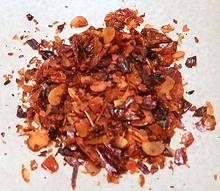 [Aji Molido (ground chili), Aji Triturado (crushed chili) (Argentina)]
[Aji Molido (ground chili), Aji Triturado (crushed chili) (Argentina)]
This is a fairly mild chili flake, about
H5 (both Molida and Triturado are flake). It is an essential
ingredient in traditional Argentine Chimichurri Sauce, which is absolutely
essential for serving with grilled meats, and without grilled meats, could
there even be an Argentina? It is often made from Aji Mirisol (dried Aji
Amarillo), usually mixed with other mild chilis. Aji Mirisol is much used
in Bolivia to the north, and the chilis are also grown in the Bolivian
corner of Argentina. The photo specimen is of an Argentine brand sold in
Argentina.
The word for chilis in Brazil is "Pimenta". While the Spanish took chilis home from Mexico and developed mild chilis in Spain, Portuguese sailors carried the stinging hot chilis of Brazil to India, East and Southeast Asia, and Africa - even to Japan.
Brazil is the origin region for species Capsicum chinense, and Capsicum frutescens is also significant there. Many interesting chilis grow in the region, but almost none of them are known or available in North America. I hope to be able to expand this section over time, though I may have to grow the chilis myself.
 [Wild Chilean Chili Pepper; Aji Charapita (Peru); Cumari (Brazil);
C. chinense]
[Wild Chilean Chili Pepper; Aji Charapita (Peru); Cumari (Brazil);
C. chinense]
This tiny chili, is very popular in Peru, and is also well known in
Brazil. It is a fairly hot chili
(H8) with a fruity flavor.
For full details see Aji Charapita on this
page.
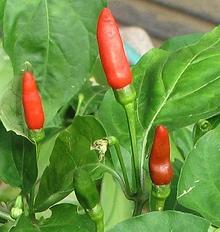 [Piri Piri, Peri Peri, etc. (Portugal, Africa); C. frutescens]
[Piri Piri, Peri Peri, etc. (Portugal, Africa); C. frutescens]
Up to 2 inches long, these are standard bird chilis. Larger ones are
called Malagueta in Brazil and Portugal, smaller ones are called Piri Piri
in Portugal and Malagueta in Brazil. They are pretty much identical to the
Piri Piri chilis of Africa, because those were brought to Africa by the
Portuguese. They are quite hot at
(H9). Subst: Thai Chilis, not as
hot but much more available. Caution: many food
writers have fallen afoul of confusion between Malagueta Peppers and
Melegueta Pepper, a spice seed in the Ginger family also known as
Grains of Paradise.
 [C. baccatum]
[C. baccatum]
These may have originated in Peru, but were domesticated in Brazil.
They are apparently quite variable, but mine are medium hot
(to H7). One small one will
provide enough heat for 5 cups of soup. The plant is rangy and sprawls,
producing prolifically in it's first year, but may produce little or
nothing in its second year. The fruit can grow to 2 inches across,
but mine only grew to 1.4 inches and 0.7 inches thick. Most were smaller.
This is a very usable chili fresh, but also dried. The crisp, slightly
sweet flesh is thick and the skin is tough, so they need to be split in
half for drying, even in a dehydrator. Once ground, the red color fades
quickly.
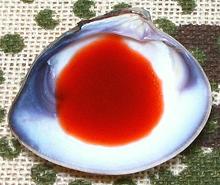 [Molo de Pimenta, Salsa de Pimenta]
[Molo de Pimenta, Salsa de Pimenta]
Probably made from Malagueta peppers, this sauce is similarly hot to
North American Tabasco sauce, but is thicker and redder because it also
contains non-hot red peppers. I find a half and half mix of Tabasco
and Tapatío gets pretty close, though the color isn't quite as
bright. The photo specimen is Predilecta brand, said to be the most
popular in Brazil. Ing: red pepper pulp, water, vinegar, salt, chili
pulp, xanthan gum, potassium sorbate.
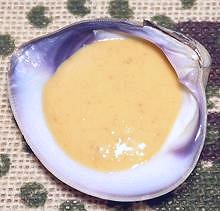 [Salsa Mendez]
[Salsa Mendez]
This Hot Sauce is now very popular in Brazil, and available on-line in
North America. Hotness is similar to our Tapatío, around
(H4), but the taste is very different.
Clearly it is made from yellow South American Chilis. Ing: Mix of special
chili peppers, vinegar, sunflower oil, sea salt, preservatives (INS) 200,202,
thickener (INS) 415, antioxidants (INS) 330.